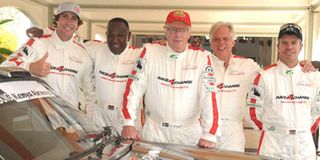Safari Rally legends’ gala dinner an idea long overdue

Legendary Kenyan rally driver Patrick Njiru (second left) in the company of fellow rally drivers Ravis Pastranas, Bjorn Waldegaard and Ian Duncan.
What you need to know:
- Patrick Njiru became a household name in Africa, and drove a Group N car, a Subaru Impreza, to its highest position, a fourth in 1994 in the WRC.
- He remains the best-ever African driver in WRC history. He even had diplomatic duties by competing in South Africa as a good example of how blacks could also excel in the whites' sporting disciplines in the rainbow nation.
Basic facts don't tell a story like deeds. Many are heroic, and few living testaments of determination in matters human dignity.
One perfect example is John Stephen Akhwari, a marathon runner who represented Tanzania at the 1968 Mexico Olympic Games.
Things went from bad to worse, and extreme worst on that fateful afternoon. It was as if the devil had woken up in a foul mood and decided to punish Akhwari.
Akhwari limped into the stadium last, one hour after the end of the race, badly bruised and in excruciating pain from a fall, stomach cramps and a dislocated arm.
A falling bandage doctors had tied on his knee by the road to stop bleeding was flapping from an evening breeze to complete a very sad picture of pain. But his performance, courage and dedication in the face of adversity are what history remembers him for.
His response to a question at the finish has gone down as one of the best quotes in sporting history. “My country did not send me 5,000 miles to start the race,” he said. “They sent me 5,000 miles to finish the race.”
A similar classic was that of the sister and brother pair of Benjamin Kariuki and Margaret Wangui.
Kariuki was a master of innovation. He modified an old car whose only identity was the Isuzu Gemini manufacturer's badge and front grill.
Everything else was cannibalised from all sorts of machines, including rusty bucket seats from a 1950 Messey Fergusson tractor, and the gearbox shift lever from a 1969 Isuzu lorry salvage.
The car was aptly nick-named "Mchuzi Mix".
This car caused a stir at the Marigat Service Park near Kabarak, Nakuru, when, with the paintwork peeling out, arrived for service, stopping not far from where world champion Tommi Makinen in a Mitsubishi Lancer was sitting furious with the Michelin boss after suffering three punctures and needing rescue after running out of tyres.
A new rule had been introduced limiting the number of tyres one would use in a section.
It was a worthy distraction for the world media which surrounded “Mchuzi Mix”, paying attention to every nook and cranny of the car.
The Michelin boss touched its size 13 tyres -a mismatch of Firestone, Dunlop, Michelin and Pirelli - which were bald with a wire lining jutting out.
He shook his head wondering just how this car could come this far while the tyres in Makinen's car took a beating in a 100-kilometre section.
He was willing to donate a complete pair but Kariuki's car was running on size 13.
DNation bodytext: Kariuki and Wangui were the heroes, and their tales of courage became a reference to resilience in the Safari that year. They never finished.
But they were the people's heroes. They and many others who built the Safari Rally remain in obscurity, unseen, and unappreciated. But this is about to change. Kariuki and tens of other veterans still alive will be finally recognised at a gala dinner on June 9 at the Safari Park Hotel.
Not since the Prize Giving Ball by the Mayor of Nairobi to wash away the dust and reward achievers at the end of every Safari Rally back in the day has the gala dinner generated such a positive reaction within the motorsport fraternity.
Everybody was a winner in the past, returning home with a memento including the last finisher whose “Tail End Charlie” trophy was more celebrated than the overall winners.
The legends’ dinner is also a reminder of the Safari's rich heritage. Not all living legends are winners, apart from maybe Ian Duncan, champion in 1994.
But this group has icons within it.
Mike Doughty won the Safari four times with the late Shekhar Mehta while Mike Kirkland picked two-second positions and one-third.
Patrick Njiru became a household name in Africa, and drove a Group N car, a Subaru Impreza, to its highest position, a fourth in 1994 in the WRC.
He remains the best-ever African driver in WRC history. He even had diplomatic duties by competing in South Africa as a good example of how blacks could also excel in the whites' sporting disciplines in the rainbow nation.




